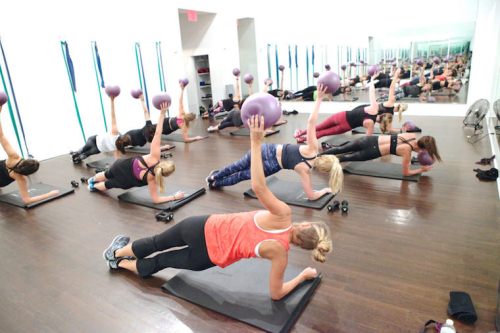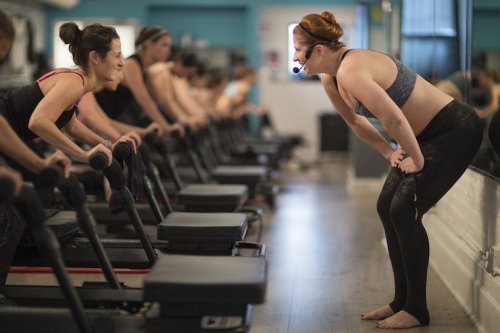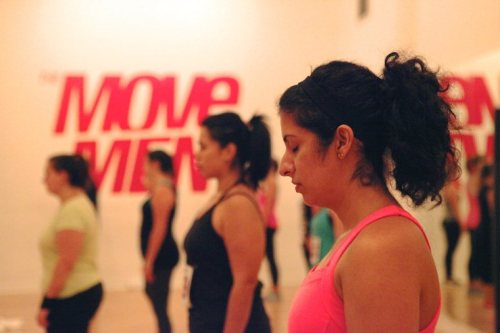The people involved in New York City’s fitness industry are currently playing a giant (sweaty) game of telephone, and the word that’s being whispered from ear to ear is “bubble.”
And yet, by all empirical measurements, the business of working out is booming.
According to the International Health, Racquet & Sportsclub Association (IHRSA), global “health club” revenue totaled $81 billion in 2015, with 151.5 million members visiting nearly 187,000 clubs. Private equity money has entered the space like never before, allowing brands like Flywheel, Pure Barre, and CorePower Yoga to rapidly multiply locations.
In NYC, more than two dozen new boutique fitness studios opened in 2016, and the pace doesn’t appear to be slowing down, with newcomers like Rumble and Switch Playground entering the scene with leases for multiple locations already signed.
When is it no longer possible to sprint at this level of intensity?
Oh, and NBD, but there are now upwards of 1,000 (yes, a thousand) fitness studios and gyms in the NYC metro area on ClassPass. Not to mention growing budget gyms, like Blink, which now has more than 50 NYC locations and recently announced an expansion into Philadelphia, and Planet Fitness, which debuted its IPO in 2015.
Naturally, all of this growth leads to questions of sustainability, like, when is it no longer possible to sprint at this level of intensity?
“There is obviously a rabid consumer appetite for this,” says Jason Kelly, author of Sweat Equity, a tome on the current financials of fitness. “It’s difficult to find hard evidence of the bubble as of yet…. But I do think that there are some constraints to the growth of the market in terms of how many different [workouts] people are willing to do at once. And from a mind share and a market share perspective, it seems to be getting pretty crowded.”

As crowded as a SoulCycle locker room at 8:00 a.m?
For examples of saturation, look no further than the sticky, drenched tanks of indoor cycling. Spinning started the group indoor cycling craze in the ’90s and then watched as the phenomenon pedaled away with its trademarked name (well, in lowercase form), making it the Kleenex of the fitness world.
“People may think boutique fitness is highly saturated, but they’re looking at it through a New York lens.”
SoulCycle opened in NYC in 2006, followed shortly after by spin-off (ha!) studio Flywheel. Fast forward 10 years, and Soul’s got 70 studios to Flywheel’s 41. In NYC, there is now Swerve, Cyc,Peloton, Revolve, Crank, Aqua Studio, Syncstudio, Monster, and many more small neighborhood spots. Even IMAX has gotten into spinning. There’s Cycle House in Los Angeles, JoyRide in Connecticut, and CycleBar opening franchises nationally.
Which points to an important, well, point. “People may think boutique fitness is highly saturated, but they’re looking at it through a New York lens, because this is one of the most competitive markets,” says Eric Posner, who co-founded Swerve after leaving a job in finance. “But you look around the world, and there are some large cities in Europe that don’t even have a boutique fitness concept there yet. Even [in] many cities in the US, you don’t see nearly as many studios.”

But of course we’re going to talk about ClassPass!
Many that see a looming bubble and its imminent burst approaching blame ClassPass for inflating said bubble.
Multiple studio owners, off the record, told me that ClassPass has allowed lots of brands with unsustainable business models to stay in the race (especially when ClassPass began funding studio expansions), which makes the market look healthier than it is. But those businesses are breathing heavy and may not make it to the finish line now that ClassPass discontinued its unlimited plan and many studios report attendance via the platform is down.
ClassPass has allowed lots of brands with unsustainable business models to stay in the race.
“There’s a reason we charge $30 or $40 for classes,” SLT founder Amanda Freeman says. “The economics are set up so that a business can survive.” With the demise of ClassPass’s unlimited plan, Freeman thinks “we’ll increasingly see that some brands are going to go out of business.”

Early signs of the ABpocalypse?
There have been a few closings. In the boutique world, Drill Fitness, The Movement, and The Run didn’t make it. Philly-based Lithe Method’s assets were seized and all of its locations shuttered recently due to issues with an attempt to expand to NYC. SoulCycle’s IPO is now on hold, although the company continues to grow.
DavidBartonGym went bankrupt in December, bringing down a few Cyc locations that were located inside its gyms. New York Sports Club has been struggling with its model, dropping to dirt-cheap prices at some locations and revamping its BFX concept by bringing in outside talent.
Kelly argues that these gyms in the “middle” (not high-end boutique, not super-cheap) are the most vulnerable. “If you can’t see very clearly the value proposition, especially when things get highly competitive, that’s a dangerous place to be,” he says.
All of these developments may be early signs of a bubble or simply examples of single players who didn’t make it in a competitive market. Of course, one key question remains, and it’s related to your wallet…

What are we willing to pay for?
The final argument I heard constantly in support of a bubble: Isn’t the world of people willing to pay more than $30 to pant and sweat for an hour limited?
Posner says no, that he sees that pool of customers growing alongside the fitness industry, as Millennials prioritize fitness like never before and shift their spending to accommodate for that.
“I have seen very little evidence that people are truly balking at the price tag for these classes.”
A spin class of $34 equals one round of drinks at the bar, he argues. “And if you think of the trend of ‘Friday nights at home watching Netflix,‘ that money people would have been spending going out is now being put towards fitness and wellness.”
Kelly concurs. “I have seen very little evidence that people are truly balking at the price tag for these classes. I think the spending is pretty firm, the question is where are they spending, how diversified is it, and how fickle is the consumer?”
In other words, will they move on to races or triathlons, leaving a messy, burst spin class bubble in their dust?
Here’s what more CEOs in the business of fitness are thinking about right now and these platforms are trying to change workout class booking (yes, again).
Sign Up for Our Daily Newsletter
Get all the latest in wellness, trends, food, fitness, beauty, and more delivered right to your inbox.
Got it, you've been added to our email list.









